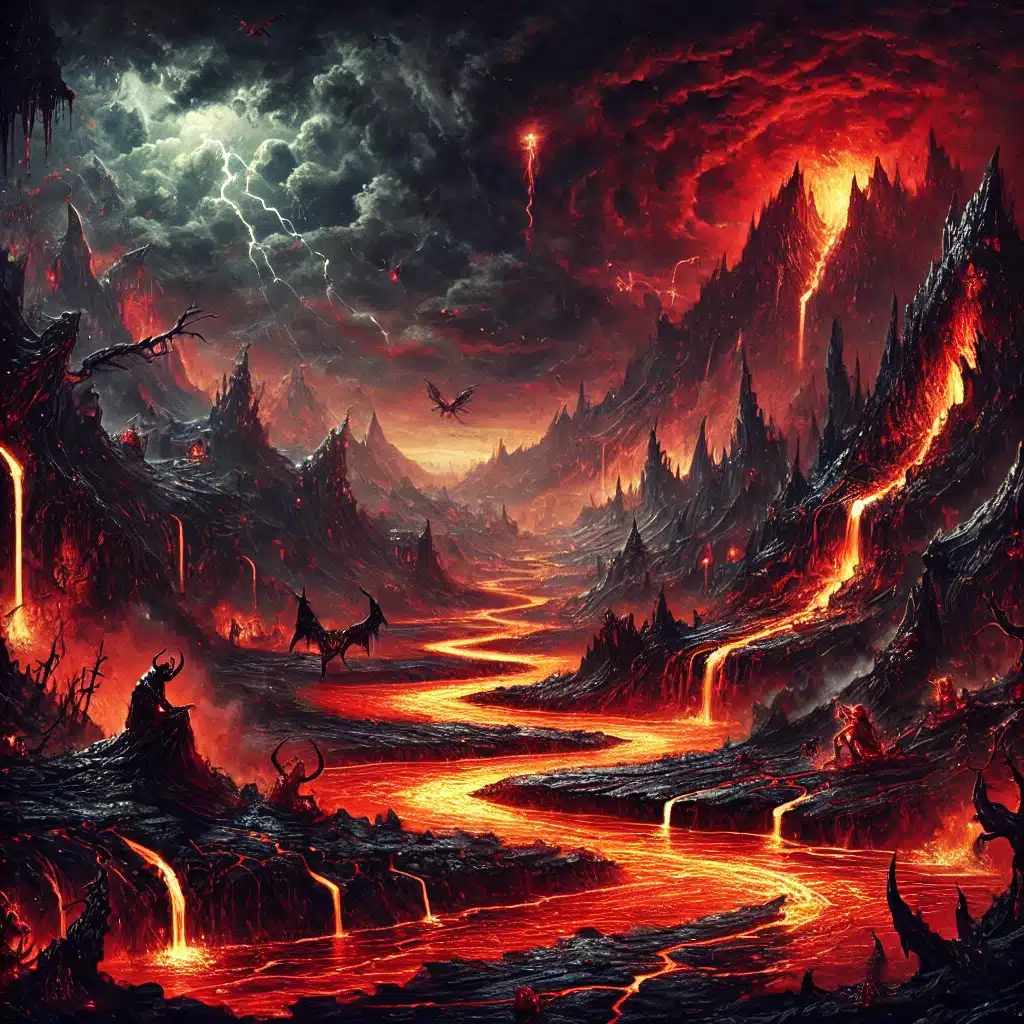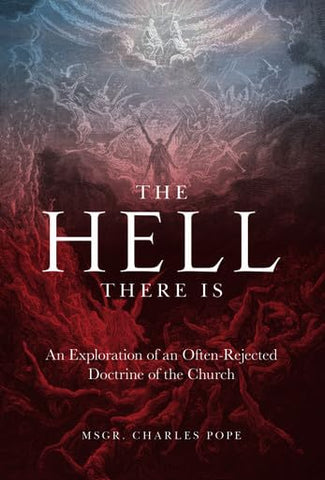
An exorcist friend recently suggested a new book by a fellow priest (and part-time exorcist), Monsignor Charles Pope, of the Washington D.C. archdiocese. We are happy to carry it in our bookstore.
For the subject is intriguing: The Hell There Is: An Exploration of an Often Rejected Doctrine of the Church.
And it certainly makes its points.
It also cuts to the chase. “No ‘heresy’ of our day is more widespread or pernicious than the denial of hell, its existence, and the sad truth that many go there,” writes Monsignor Pope.
An easily read but a bit sobering book this can be, especially for those who deny what Jesus Himself taught–in twenty-one of His thirty-eight parables!
That rejection of doctrine is often rooted in the idea that hell does not comport with a loving, charitable Father.
God wants to save us all. No one loves us as much as Jesus. But another aspect: God gives us a choice. He cherishes our free will. We choose the netherworld with the choices in our lives.
How many go to hell?
The Lord said, “Enter by the narrow gate. For the gate is wide and the way easy that leads to destruction, and those who enter by it are many.” Those who find it (said the Lord, as Pope points out) “are few.”
The question: do the rest go to hell, or: purgatory? For the lowest reaches of purgatory have been described in another major revelation, An Unpublished Manuscript on Purgatory, as being virtually identical to hell but without the demons. Many who have had alleged “near-death experiences” describe a hellish realm, but far more often, the beauties of Heaven.
Monsignor Pope mainly relies on Church teachings, especially those of saints, and several private revelations such as Fatima, where seer Lucia dos Santos she and her two cousins witnessed “a vast sea of fire. Plunged in this fire, we saw demons and the souls [of the damned].
“The latter were like transparent embers, all blackened or burnished bronze, having human forms. They were floating about in that conflagration, now raised into the air by the flames which issued within themselves, along with great clouds of smoke.” The demons bore a “repellent likeness to frightful and unknown animals, black and transparent like burning coals.”
A similar glimpse was granted to seers at Medjugorje in Hercegovina, where one visionary described a beautiful woman who entered the flames and exited as a frightful creature, half human, half beast. There the seer, Vicka Ivanković, said that “the deeper they enter into the fire, and the deeper they go, the more they rage against Him. When they come out of the fire, they don’t have human shape anymore; they are more like grotesque animals, but unlike anything on earth, as if they were never human beings before. They were horrible. Ugly. Angry. And each was different; no two looked alike. When they came out, they were raging and smashing everything around and hissing and gnashing and screeching.” It was so bad that the youngest seer—Jakov Ĉolo (who saw hell with Vicka)—generally refuses to speak of it. (During their “visit” to the afterlife, the two visionaries–at this site that has obtained an official Jubilee indulgence–inexplicably disappeared from Jakov’s home.)
“We all know that there are persons on this earth who simply don’t admit that God exists, even though He helps them,” said Vicka. “He always tries to nudge them onto the path of holiness.
“They just say they don’t believe, and they deny Him. They deny Him, even when it is time to die. And they continue to deny Him after they are dead. It is their choice.
“It is their will that they go to hell. They choose hell.”
The Virgin allegedly explained that “the majority of people go to purgatory. Many go to hell. A small number go directly to Heaven.” This matches how Jesus used the word “many” (above) and spoke of the “outer darkness.”
Is that outer darkness purgatory or hell?
In Monsignor Pope’s view, it is indeed the abyss.
“We spend a lot of time trying to be on top of this world,” writes the priest, who once had a popular blog. “We want comfort, wealth, position, and power. Here, the Lord warns us of the coming great reversal. Lazarus, who was poor, is now rich, while the rich man is now poor.”
Lust. Gluttony. Lying. Greed. Pride. Lack of charity. Most importantly, rejection of God.
Long is the list of dangerous transgressions; Lent is a powerful time to confess and purge them.
It’s also the time of year we remember Sister Faustina Kowalska, who wrote that “by the order of God” she had “visited the Abysses of Hell so that I might tell souls about it and testify to its existence…the devils were full of hatred for me, but they had to obey me at the command of God, What I have written is but a pale shadow of the things I saw. But I noticed one thing: That most of the souls there are those who disbelieved that there is a hell.” (Diary 741)
“Today, I was led by an angel to the Chasms of Hell. It is a place of great torture; how awesomely large and extensive it is! The kinds of tortures I saw:
The First Torture that constitutes hell is:The loss of God.
The Second is:
Perpetual remorse of conscience.
The Third is That one’s condition will never change.
The Fourth is: The fire that will penetrate the soul without destroying it. A terrible suffering since it is a purely spiritual fire, lit by God’s anger.
The Fifth Torture is: Continual darkness and a terrible suffocating smell, and despite the darkness, the devils and the souls of the damned see each other and all the evil, both of others and their own.
The Sixth Torture is: The constant company of Satan.
The Seventh Torture is: Horrible despair, hatred of God, vile words, curses and blasphemies.”
Enough said (though for more, see the footnotes).
Monsignor’s book?
Recommended!
[resources: The Hell There Is]
We appreciate your support! God’s peace.
[See also: An Unpublished Manuscript on Purgatory and The Diary of Saint Faustina]
[Footnote from The Diary of Divine Mercy: “These are the Tortures suffered by all the damned together, but that is not the end of the sufferings.
“Indescribable Sufferings
There are special Tortures destined for particular souls. These are the torments of the senses. Each soul undergoes terrible and indescribable sufferings related to the manner in which it has sinned.
“I would have died
There are caverns and pits of torture where one form of agony differs from another. I would have died at the very sight of these tortures if the omnipotence of God had not supported me.
“No One Can Say There is No Hell
Let the sinner know that he will be tortured throughout all eternity, in those senses which he made use of to sin. I am writing this at the command of God, so that no soul may find an excuse by saying there is no hell, or that nobody has ever been there, and so no one can say what it is like…how terribly souls suffer there! Consequently, I pray even more fervently for the conversion of sinners. I incessantly plead God’s Mercy upon them. O My Jesus, I would rather be in agony until the end of the world, amidst the greatest sufferings, than offend you by the least sin.’ (Diary 741)”]
+


